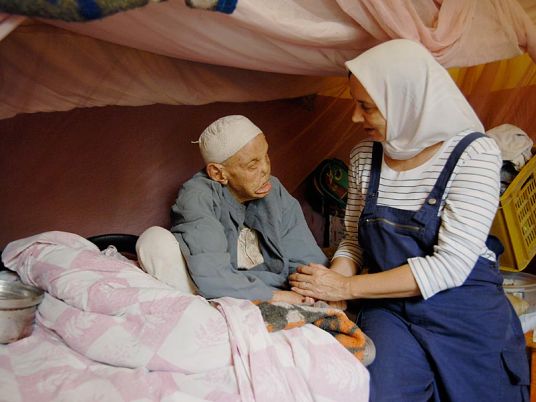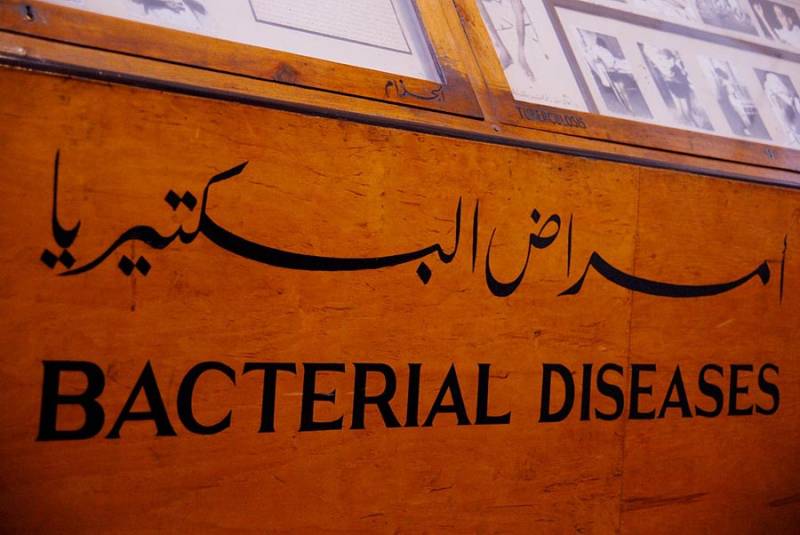
Although leprosy is on the verge of extinction and many people have completely forgoten about this disease, there are still some leprosaria, or leprosy colonies as they are often called. This is not a story about suffering and misery, but rather about a strange micro-cosmos, a place unknown to most people: the leprosy colony Abu Zaabal in Qalyoubiya, 40km north of Cairo. All tourists that fly into Cairo could see it from above as it is quite close to the airport if they would know that it is there. About 750 patients are still living there, and another 3,000-4,000 cured lepers are living in the adjoining Abdel Moneim Riad village.

The bacterium responsible for leprosy was discovered in 1873 by the Norwegian Dr Armauer Hansen, and a whole section in Cairo’s Agricultural Museum was dedicated to bacterial diseases like leprosy and tuberculosis. The display in the museum remains as if nothing has changed since.

Until the 1930s, the illness was seen as uncurable and highly infectious. Left untreated, leprosy can be progressive, causing permanent damage to the skin, nerves, limbs and eyes. In fact, leprosy is not highly infectious, as approximately 95% of people are immune and sufferers are no longer infectious after only a couple of days treatment.

Abu Zaabal was built in 1933 encompassing a hospital…

…and agricultural land in order to be self-sustainable.

Lepers were brought in by police and were not allowed to leave for isolation was seen as the only treatment. It was a big open air prison. Circumstances back then were horrible with mice chewing away on lepers’ wounds while they slept.

Over the past decade Abu Zaabal has received a total make-over and has become a more friendly, peaceful place with all of the necessary facilities.

When Dr Karam Shakshak and Dr Ahmed Al Thokaby, the recent director, arrived at the beginning of this decade, they first renewed the water station as the whole place had no clean water at all. Now there is a waste water treatment plant on the grounds of the colony and provides the hospital with clean water.

Ibrahim, a cured patient operates the barber shop.

A little mosque is frequented often by everybody who can walk. A priest visits Christian patients regularly.


The colony has its own bakery.

What would be a micro cosmos without a coffeeshop? Radi, another ex-patient is managing the coffeeshop.

Nadia, his wife, a fragile and very sick woman, often gives him company.


Three Comboni Sisters and two Elisabetine Sisters, two Italian orders, come every morning from Cairo-Heliopolis to Abu Zaabal to help the leprosy patients. Sister Vittoria (left) has lived for 45 years in Egypt and works for 26 years in Abu Zaabal.

Abu Zaabal has a big section for men and a smaller for women because generally less women get infected by leprosy. There are bigger and smaller sleeping wards, where every patient has his/her own bed and cupboard. Most rooms have a TV as well.

Patients who lost their legs or parts of it get well fitting protheses and learn to live with them. Often it was impossible for me to differentiate.

All wards have their own kitchens where men or women cook together like in a flat share. But for those who are to weak and sick there is a big kitchen where healthy food is prepared for them.

Abdullah, also a cured leper, helps to distribute the food to the patients.

Abdullah also helps with cleaning.

Most mornings patients with open wounds come to the clinic to get their bandages changed.

In the old days, patients received one bandage per month and had to wash it with unclean water every few days.

In the early mornings Ibrahim, also an ex-patient, helps change bandages.

I was worried about taking photos while patients have their bandages changed. But unexpectedly I found a relaxed atmosphere. The guys were chatting with each other and even joking. It is part of their daily routine and they exchange news while a nurse cleans out their wounds.


The operation rooms received better equipment, especially for ear, nose and throat operations. And most importantly the hospital received a back-up generator after power cuts occurred during surgery causing a disasters.

In fact the hospital here is now better equipped and kept cleaner than many governmental hospitals in Egypt.

After helping in the clinic Ibrahim continues working in his little workshop where he fabricates special shoes for those who have deformations on their feet.

Six years ago Jehad, aka Manuela, a German woman, who has lived in Egypt for more than 20 years, turned the uncared of and full of rubbish grounds of Abu Zaabal into a paradise-like garden.

A team of 13-15 men, all cured patients, are helping to keep the garden clean and beautiful. They receive a small salary for their work. Most ex-lepers, especially if they have deformations can’t find jobs anymore.

Ahmed Mohamed (49) is one of them. The disease started when he was 18, but like many others the doctor discovered very late that he was suffering from leprosy. In 1980 he came to Abu Zaabal and received Multi Drug Treatment (MDT) and was finally cured. He met his wife here, also a common story, and they have five healthy children.


Jehad does not only take care of the garden she also visits those patients who suffered so much from leprosy that thy have to spend their lives in bed. Sheikh Sayed, 88, suffered from leprosy since he was six years old. But only when he had an eye operation at the age of 18 the doctor diagnosed him with leprosy.

For 63 years now, he has lived in Abu Zaabal, blind, with disfigured mouth and nose and limps. But he listens to the radio every day and is up to date with world news.

Despite his tough destiny he still likes to joke. “Hagiblik gateau?” “Can I get you some cake?” he said and giggled at his own joke when I spoke to him.

Gohari ,18, is the youngest male patient at Abu Zaabal. He finished his MDT treatment and now receives physiotherapy for his hands. Effective treatment for leprosy appeared in the late 1930s with the introduction of dapsone and its derivatives. However, leprosy bacilli resistant to dapsone gradually evolved and became widespread, and it was not until the introduction of Multi Drug therapy (MDT) in the early 1980s that the disease could be diagnosed and treated successfully. Belonging to the younger generation Gohari does not want to spend his life in the colony but wishes to go return to Kafr El Sheikh, his home town, and continue school.

The older patients, who live 30, 40 years or even longer in the colony don’t want to return to their often rural villages.

In the past they were often stigmatized and had to live the lives of pariah. So they got married in Abu Zaabal, moved to the neighbouring village and made their homes here. Also nowadays the living conditions in Abu Zaabal itself are much better than in a rural poor Egyptian village where most patients come from.

He is visiting his grandmother and shows off some of his religious tattoos.

Many patients have old fashioned cookers and brew their own tea.


Cooking together comes often with little arguments about taste and ingredients. It reminded me very much of some of my own flat share experiences and arguments about who should cut the darn onions.


His father had just his second leg amputated. He was another case where leprosy was way too late in being diagnosed.

The approximately 55 nurses sometimes have exhausting days. Although many of those I talked said that they enjoy their work at Abu Zaabal.

About 120 women patients are living at Abu Zaabal, and about another 130 come here fror treatment.

Saneya (85) has lived here for more than 50 years.

Although she has deformed feet and hands she manages to walk around and prepare her own food. I had many funny conversations with here and couldn’t believe how lucid she is. She loves to sing, tease other younger patients and has a wicked humor. She kept nagging me to bring along my boyfriend to check him out.





The women also have their communal kitchen where they can cook together while others opt to cook on a small stove beside their beds.


He and his wife come in daily to sell vegetables to the patients.


Warda (80) has lived there for 35 years and loves to listen to soap operas and music on her radio.




Sister Laura is the only Egyptian nun at the colony and has worked here for five years as a nurse.

Every morning she visits all women, gives injections,…

….cleans wounds,…


….combs hair…..

and consoles, laughs and jokes with them.

Everybody who is strong enough does washing, cleaning, cooking and helps those who aren’t. Life here is like in a big community, but somehow totally detached from the outside world.








As one of Abu Zaabal’s biggest donors Caritas Egypt founded in 1982 a socio-medical centre in adjoining Abdel Moneim Riad village. In their preschool/kindergarden they serve about 120 children of lepers and ex-lepers. The children learn reading and writing,…

….get one healthy meal including fresh milk.

And get to play in their new playground.



Dr. Mona, the dermatologist of Abu Zaabal for more than 30 years, comes three times a week to the Caritas Centre to treat children free of charge.


Italian Sister Lina (88), as old as the oldest patients, is the coordinator of the Caritas Centre. It is more and more difficult to find young women who would serve as nuns for the poor.

The centre also provides women with courses in sewing. Some of products are later on sold at the center.

The one kilometre between Abu Zaabal and Abdel Moneim Riad village people walk or take pick-ups and microbuses.

Nobody knows exact numbers but approximately 650 families live in this village.

Zeinab from Upper Egypt, is an ex-patient of Abu Zaabal where she met her husband. They settled down here, had three healthy children. Now Zeinab sells vegetables in the street in front of her house. Here she doesn’t have to fear from stigma and horrible comments.

Fresh milk for four Egyptian Pounds per litre (60 US dollar cents) is unaffordable for many people.


Many of the villagers remain dependent on the colony because of their deformations and receive necessary medications and support from it.

Doaa, 30, cured, also met her husband in the hospital and they decided to settle here after her husband worked in a cheese factory but were fired when they found out that he had suffered from leprosy. Now they have built a little house and she opened a grocery shop and is very proud that she can contribute to their living. The ultimate goal for leprosy patients in Egypt is to live a normal life in their communities, receive treatment there and go on with their lives.
This story originally appeared in Claudia Wiens Photograph blog in February 2009. Wiens recently revisited the leprosy colony and told Egypt Independent that the center is always looking for help.
“Zaabal is always happy to welcome volunteers of all sorts, medical professionals, social workers or simply people who could share some of their time to help patients or to renovate or repair facilities,” Wiens said, adding that donations are also needed. “Some of the medical equipment is really old like for example the x-ray machines and new ones are urgently needed. People who would like to help can visit Abu Zaabal, talk to the nuns there and find out which help would be useful right now.”
